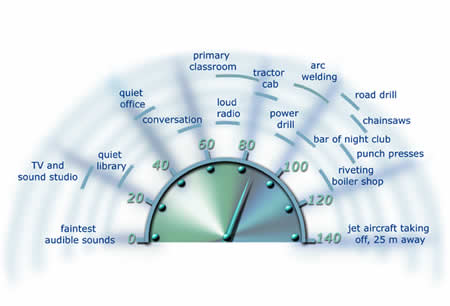Noise at Work Regulations
Do NOT adjust the volume after starting to listen to the clip. The hearing loss simulations all include the effects of noise exposure and ageing. At the end of each simulation the hearing undamaged by noise for the age can be heard.
Control of Noise at Work
The Control of Noise at Work Regulations 2005 (the Noise Regulations) came into force for all industry sectors in Great Britain on 6 April 2006 (except for the music and entertainment sectors, where they come into force on 6 April 2008).
The aim of the Noise Regulations is to ensure that workers' hearing is protected from excessive noise at their workplace, which could cause them to lose their hearing and/or to suffer from tinnitus (permanent ringing in the ears)
The control of Noise at Work Regulations 2005 replace the Noise at Work Regulations 1989 (except for the music and entertainment sectors where the 1989 Regulations will continue to apply until 6 April 2008).
The level at which employers must provide hearing protection and hearing protection zones is now 85 decibels (daily or weekly average exposure) and the level at which employers must assess the risk to workers' health and provide them with information and training is now 80 decibels.
There is also an exposure limit value of 87 decibels, taking into account any reduction in exposure provided by hearing protection, above which workers must not be exposed.
Sound Service can offer a wide range of sound insulating products to address any noise issues and help you comply with these new regulations.
Do you have a noise problem at work?
This will depend on how loud the noise is and how long people are exposed to it. As a simple guide you will probably need to do something about the noise if any of the following apply:
Is the noise intrusive - like a busy street, a vacuum cleaner or a crowded restaurant - for most of the working day?
Do your employees have to raise their voices to carry out a normal conversation when about 2 m apart for at least part of the day?
Do your employees use noisy powered tools or machinery for more than half an hour each day?
Do you work in a noisy industry, eg construction, demolition or road repair; woodworking; plastics processing; engineering; textile manufacture; general fabrication; forging, pressing or stamping; paper or board making; canning or bottling; foundries?
Are there noises due to impacts (such as hammering, drop forging, pneumatic impact tools etc), explosive sources such as cartridge operated tools or detonators, or guns?
How Loud IS loud?
How is noise measured?
Noise is measured in decibels (dB). An 'A-weighting' sometimes written as 'dB(A)', is used to measure average noise levels, and a 'C-weighting' or 'dB(C)', to measure peak, impact or explosive noises. You might just notice a 3 dB change in noise level, because of the way our ears work. Yet every 3 dB doubles the noise, so what might seem like small differences in the numbers can be quite significant.

i do have a problem? what do i do next?
Once you are aware of the level of noise you are producing then give us a call. We will normally be able to find a solution for you over the phone. In some cases we will send one of out team to you to access what systems of ours you will need to put in place.
Normally the best way of treating noisy machinery is to create an enclosure around it. This is similar to our pump soundproofing page see HERE.
We have a range of products to reduce reverberation on walls and ceilings in the workspace.
Click HERE to see our ceiling products
Click HERE to see our wall products
Click HERE to see our Industrial baffles and foams
For more information contact our specialist technical team on 0845 363 7131
Written by Stephen Young
© Sound Service (Oxford) Ltd. 2008
Image and information courtesy of www.hse.gov.uk/noise/


